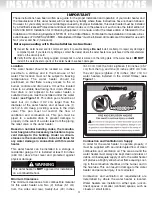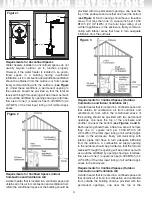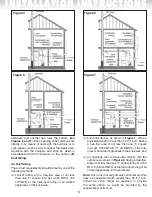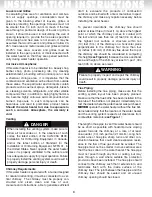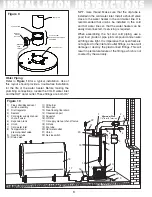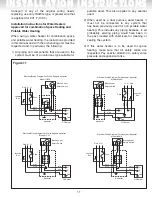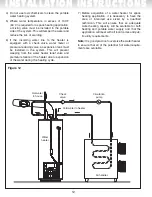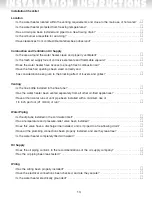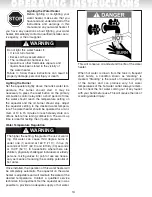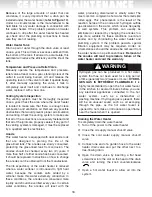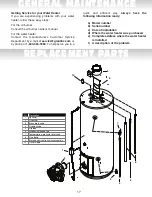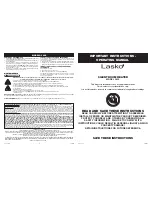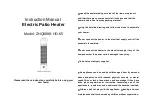
9
INSTALLATION INSTRUCTIONS
Temperature and Pressure-Relief Valve
DO NOT
plug the temperature and pressure-
relief valve or its discharge line.
DO NOT
remove
the relief valve. Make sure the relief valve is prop-
erly sized for the water heater. If the relief valve
continuously discharges water, call a qualified
service technician to correct the problem. Failure
to follow these instructions can result in property
damage, personal injury or death.
To protect from excessive pressure and/or temperature,
the manufacturer has installed a temperature and
pressure-relief valve that meetswith the requirements
of the Standard for Relief Valves and Automatic Gas
Shut-Off Devices for Hot Water Supply Systems, CSA
4.4, in Canada, and ANSI Z21.22, in the United
States. This relief valve has a maximum set pressure
that does not exceed the hydrostatic working pressure
of the water heater (150 psi = 1,035 kPa) and a BTU/h
rating equal to or greater than the input rating, as
shown on the water heater rating plate. It should never
be plugged or removed from the opening marked for it
on the water heater.
If this relief valve should needs to be replaced, use
only a new temperature and pressure-relief valve.
Never install an old or existing relief valve, as it
may be damaged or inadequate for the working
requirements of the new water heater. This new relief
valve must meet with all local codes or, at a
minimum, the requirements listed above. Never
install any other type of valves between the relief
valve and the water heater.
A discharge line must be installed into the relief
valve.
The discharge line:
• Must not be smaller than the outlet pipe size of
the relief valve.
• Must not terminate less than six (6) inches (15.2
cm) and not more than twelve (12) inches (30.5
cm) above a floor drain.
• Must not be restricted in any way. Do not thread,
cap or in any way restrict the end of this outlet.
• Must be of a material capable of withstanding
210˚F (99˚C) without distortion.
• Must be installed to allow complete drainage of
the relief valve and discharge line.
• Must terminate at an adequate free-flowing drain.
Pressure Build-up in a Water System
When the water heater operates, the heated water
expands creating a pressure build-up. This is a
natural function and is one of the reasons for
installing a temperature and pressure-relief valve. If
the cold water supply line has a built-in water meter,
check valve or pressure-reducing valve, a suitable
expansion tank must be installed to prevent pressure
build-up or water hammer effect. Otherwise, the
warranty will be void
(see Figure 10)
. An indication
of pressure build-up is frequent discharges of water
from the relief valve. If the relief valve discharges
water on a continual basis, it may indicate a
malfunction of the relief valve and a qualified service
technician must be called to have the system
checked and the problem corrected.
Filling the Water Heater
NEVER
operate the water heater unless it is
completely filled with water. Failure to follow this
instruction can result in premature failure of the
water heater that is not covered by the warranty.
Check that all of the water piping connections have
been made. To fill the water heater:
1) Make sure that the water heater drain valve is
closed by inserting a flat head screwdriver into the
slot on the head of the drain valve and turning the
knob clockwise .
2) Open the cold water supply manual shut-off valve.
This valve must remain open, as long as the water
heater is in use. Never operate the water heater
with the cold water supply manual shut-off valve
closed.
3) To make sure the water heater is completely filled
with water, open hot water faucets to let the air out
of the water heater and plumbing system. Leave
the faucets open until a constant flow of water is
obtained.
4) Check all of the plumbing connections to make
sure there are no leaks.
Oil Supply
The entire fuel system should be installed in accor-
dance with all local codes or, in the absence of such
codes, the latest edition of the CAN/CSA B139,
Installation for Oil Burning Equipment, in Canada,
and/or the latest edition of the Installation of Oil
Burning Equipment, NFPA 31, in the United States.
Use only approved fuel oil tanks, piping, fittings, oil
filters and any other fuel handling components.
Install the oil filter as close to the burner as possible.
For further details of the oil supply tank and piping
requirements, please refer to the instructions and
WARNING
WARNING



